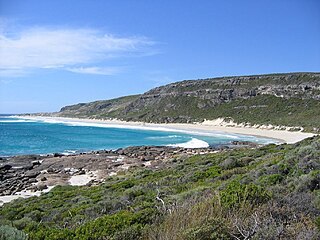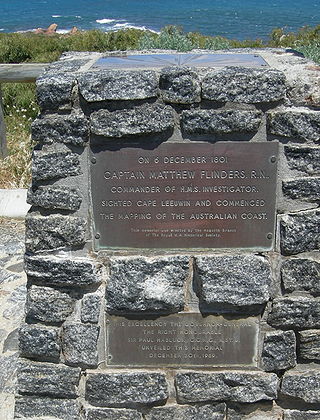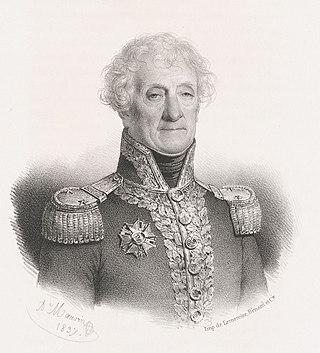
Margaret River is a town in the South West of Western Australia, located in the valley of the eponymous Margaret River, 277 kilometres (172 mi) south of Perth, the state capital. Its Local Government Area is the Shire of Augusta-Margaret River.

Leeuwin-Naturaliste National Park is a national park in the South West region of Western Australia, 267 km (166 mi) south of Perth. It is named after the two locations at either end of the park which have lighthouses, Cape Leeuwin and Cape Naturaliste. It is located in the Augusta-Margaret River and Busselton council areas, and is claimed to have the highest visiting numbers of any national park in Western Australia. The park received 2.33 million visitors through 2008–2009.
The Swan River Colony, also known as the Swan River Settlement, or just Swan River, was a British colony established in 1829 on the Swan River, in Western Australia. This initial settlement place on the Swan River was soon named Perth, and it became the capital city of Western Australia.

Louis Claude de Saulces de Freycinet was a French Navy officer. He circumnavigated the Earth, and in 1811 published the first map to show a full outline of the coastline of Australia.

Nicolas Thomas Baudin was a French explorer, cartographer, naturalist and hydrographer, most notable for his explorations in Australia and the southern Pacific. He carried a few corms of Gros Michel banana from Southeast Asia, depositing them at a botanical garden on the Caribbean island of Martinique.

Cape Leeuwin is the most south-westerly mainland point of the Australian continent, in the state of Western Australia.

Flinders Bay is a bay that is immediately south of the townsite of Augusta, and close to the mouth of the Blackwood River.

Hamelin Bay is a bay and a locality on the southwest coast of Western Australia between Cape Leeuwin and Cape Naturaliste. It is named after French explorer Jacques Félix Emmanuel Hamelin, who sailed through the area in about 1801. It is south of Cape Freycinet.
St Alouarn Islands are a group of islands and rocks south-east of Cape Leeuwin in Western Australia, approximately 11 km south of Augusta in Flinders Bay.

Geographe Bay is in the south-west of Western Australia around 220 km southwest of Perth.

Baron Jacques Félix Emmanuel Hamelin was a rear admiral of the French navy and later a Baron. He commanded numerous naval expeditions and battles with the Royal Navy as well as exploratory voyages in the Indian Ocean and the South Seas.

Cape Freycinet is a point on the coast between Cape Leeuwin and Cape Naturaliste in the south west of Western Australia.
The Baudin expedition of 1800 to 1803 was a French expedition to map the coast of New Holland. Nicolas Baudin was selected as leader in October 1800. The expedition started with two ships, Géographe, captained by Baudin, and Naturaliste captained by Jacques Hamelin, and was accompanied by nine zoologists and botanists, including Jean-Baptiste Leschenault de la Tour, François Péron and Charles-Alexandre Lesueur as well as the geographer Pierre Faure.

The Cape to Cape Walk Track is a long-distance walk trail located in the far south-west corner of Western Australia, 250 kilometres (160 mi) south of Perth. It meanders along the whole length of the Leeuwin-Naturaliste Ridge, which forms the backbone of the Leeuwin-Naturaliste National Park. Its start and finish are the lighthouses at the tips of Cape Naturaliste and Cape Leeuwin. The Track extends over 123 kilometres (76 mi) of coastal scenery, sheltered forests and pristine beaches, and is in close proximity to the caves, vineyards and other features and attractions of the South West Capes – Margaret River region.

Géographe was a 20-gun Serpente-class corvette of the French Navy. She was named Uranie in 1797, and renamed Galatée in 1799, still on her building site. Her builder refused to launch her, as he had not been paid to that time. Finally launched in June 1800, she was renamed Géographe on 23 August 1800.

Naturaliste was one of the two-vessel Salamandre-class of galiotes à bombes of the French Navy. Under Jacques Hamelin, and together with Géographe she took part in the exploration of Australia of Nicolas Baudin.
Charles-Pierre Boullanger (1772-1813) was a French geographer who served on Nicolas Baudin’s scientific expedition to the South Seas from 1800 to 1803. He was a midshipman cartographer and hydrographic engineer on the survey vessel Le Géographe with the sister ship Naturaliste. During this expedition he produced, with Charles-Alexandre Lesueur, a detailed map of the east coast of Australia.
The Freycinet Map of 1811 is the first map of Australia to be published which shows the full outline of Australia. It was drawn by Louis de Freycinet and was an outcome of the Baudin expedition to Australia. It preceded the publication of Matthew Flinders' map of Australia, Terra Australis or Australia, by three years.
Cape Mentelle is a limestone headland on the Indian Ocean coast of south-western Western Australia. It is within the Leeuwin-Naturaliste National Park, just north of the mouth of the Margaret River and 9 km (5.6 mi) west of the town of Margaret River. It lies on the Leeuwin-Naturaliste Ridge, halfway between Cape Naturaliste 50 km (31 mi) to the north, and Cape Leeuwin 50 km (31 mi) to the south, on the route of the Cape to Cape walking track.
Cape Hamelin is a headland seven kilometres south of Hamelin Bay in the capes region of south western Western Australia.













